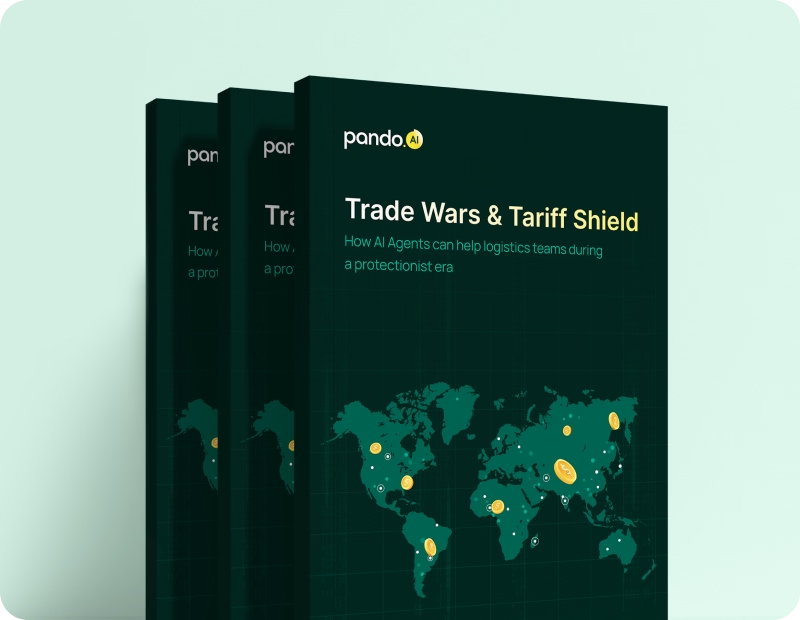-
Products Products
- Industry
- Initiatives
- Resources
- Company
- Book a demo

Before you go: Logistics leaders just dropped the truth on AI
The State of AI in Logistics 2025 is here — no hype, just real conversations and raw insights.
The future of supply chain: Trends that will define 2024 and beyond
Maximize savings and streamline processes with a proactive freight pre audit approach.
Published on January 18, 2025 • 6 mins read
Rohit Lakshman

Maximize savings and streamline processes with a proactive freight pre audit approach.
Since the early 2000s, supply chain professionals have recognized the potential of artificial intelligence (AI) and machine learning (ML) to enhance industry efficiency, sustainability, and resilience. However, it wasn’t until recent years that these technologies truly began to deliver on their promise, driving the widespread adoption of supply chain digitalization. Today, AI and ML and other supply chain innovations such as generative AI, IoT, and blockchain are no longer merely experimental tools but are on the path to becoming integral components of the modern supply chain.
From leveraging AI to forecast demand fluctuations to using low-code platforms to streamline logistics, the opportunities for optimization are vast. Companies ready to embrace these changes will gain significant competitive advantages, while those that hesitate risk falling behind.
In this blog, we will explore new and emerging trends that build up on the capabilities of AI and other technologies in logistics. Understanding how these future trends and innovations impact supply chains can help you adapt to industry changes, mitigate risks, and create a more agile and competitive supply chain.
Seven supply chain trends of 2024
When we look at the supply chain, we see a system designed to connect ideas, resources, and people. As technology evolves, so do the possibilities within this intricate web. Gartner has identified seven key trends shaping the supply chain landscape for 2024. Let’s explore these trends with clarity and purpose, focusing on practical insights you can apply.
1. Cyber extortion: Strengthening defense strategies
Cyber extortion is an escalating threat, with attackers leveraging AI to execute advanced ransomware attacks on supply chain organizations. These attacks disrupt operations, compromise sensitive data, and demand hefty payouts. To counter this, organizations must proactively collaborate closely with IT leadership to include ransomware scenarios in their corporate risk management processes. Developing a ransomware incident response playbook ensures a clear course of action when faced with such attacks.
For instance, a logistics company experiencing a ransomware attack on its route optimization system minimized disruption by implementing pre-planned countermeasures. Their incident response playbook facilitated quick containment, restoring operations within hours. Investing in cybersecurity tools, conducting regular employee training, and simulating attack scenarios are essential steps to safeguard supply chains against increasingly sophisticated cyber threats.
2. Supply chain data governance: Enabling better decisions
With the growing adoption of advanced analytics and AI, supply chain organizations rely heavily on accurate, high-quality data for effective decision-making. Data governance ensures this reliability by maintaining consistency, integrity, and security across the supply chain ecosystem. By implementing robust governance practices, businesses can enable cross-functional visibility, automate decisions, and model various scenarios to predict outcomes.
For example, a global retailer used AI-powered analytics to streamline its transportation management. However, poor data quality initially caused inaccuracies in demand forecasts, leading to inefficient route planning and higher operational costs. After implementing a strict data governance framework, the company improved data accuracy and consistency, enabling more precise demand forecasting, optimized route scheduling, and reduced delays, ultimately lowering transportation expenses and enhancing delivery performance.
3. End-to-end sustainable supply chains: Building compliance and value
Sustainability is no longer just a corporate responsibility initiative; it has become a regulatory necessity driven by global legislation. Supply chain organizations must now ensure that their sustainability data is not only accurate but also of investment-grade quality to meet stakeholder expectations and compliance requirements. By tracking and reporting metrics such as carbon emissions, energy consumption, and waste management, businesses can align with these regulations while making informed decisions internally.
For instance, Unilever adopted a transparent supply chain model to measure and reduce carbon emissions. By leveraging advanced tracking systems, the company met compliance requirements and demonstrated its commitment to sustainability, winning the trust of environmentally conscious consumers and investors.
Organizations must invest in technology that provides precise sustainability data and use it to create actionable strategies, driving both compliance and long-term value creation.
4. AI-enabled vision systems: Automating insight
AI-enabled vision systems combine industrial 3D cameras, computer vision software, and advanced AI to analyze visual data in real-time. These systems autonomously capture and interpret images to streamline operations like quality control, inventory management, and order fulfillment. By minimizing human error and accelerating processes, AI vision systems are becoming indispensable in modern supply chains.
A leading automotive manufacturer, for example, integrated AI-enabled vision systems into its assembly line. The system identified defects in parts with remarkable precision, reducing the time spent on manual inspections and minimizing defective shipments. This automation enhanced both efficiency and product quality.
5. Augmented connected workforce: Optimizing human potential
The Augmented Connected Workforce (ACWF) strategy focuses on combining human skills with intelligent technologies to enhance productivity and decision-making. By using tools such as workforce analytics, augmented reality (AR), and smart devices, this approach accelerates onboarding, reduces training time, and ensures employees reach their full potential quickly. The ACWF strategy treats technology, analytics, and workforce augmentation as a unified system, fostering seamless collaboration between humans and machines.
A study published in The International Journal of Advanced Manufacturing Technology found that an augmented reality (AR) tool enabled warehouse pickers to complete orders an average of 37% faster compared to traditional paper-based methods. Employees adapted quickly to their roles, enhancing overall efficiency.
Organizations adopting ACWF can unlock greater value from their workforce, improve operational accuracy, and respond swiftly to dynamic supply chain demands, creating a robust foundation for growth.
6. Composite AI: Tailored intelligence for diverse challenges
Composite AI refers to the integration of multiple AI techniques to address complex supply chain challenges with precision. The industry is anticipated to increase at a CAGR of 36.5% from 2023 to 2028, potentially reaching around USD 4.4 billion by 2028. Unlike single-method approaches, composite AI combines techniques such as machine learning, natural language processing, and predictive analytics to create tailored solutions for specific use cases. This enables organizations to broaden their knowledge representations and improve decision-making across various supply chain functions.
For example, a global e-commerce company used composite AI to optimize last-mile delivery. By combining predictive analytics for demand forecasting and computer vision for real-time route adjustments, the company reduced delivery times significantly while maintaining cost efficiency.
7. Next-generation humanoid working robots: Revolutionizing labor
Next-generation humanoid robots are reshaping supply chain operations by taking on tasks traditionally performed by humans. These robots combine sensory awareness, mobile manipulation, and dynamic locomotion to work efficiently in environments designed for people. Equipped with sensors, cameras, and AI, humanoid robots can navigate complex spaces, handle materials, and perform repetitive tasks with precision, reducing labor costs and enhancing productivity.
For example, a logistics company integrated humanoid robots into its distribution center to assist with sorting and packing. These robots could adapt to various package sizes and weights, ensuring consistent output during peak seasons. The company reported a 25% increase in throughput without overburdening its human workforce.
Humanoid robots bridge the gap between automation and adaptability, offering businesses scalable solutions for labor-intensive operations. Their deployment in supply chains creates opportunities for innovation, cost efficiency, and operational resilience.
Conclusion: Leading the way forward
Supply chains are intricate ecosystems—dynamic, interconnected, and foundational to progress. The trends emerging in 2024—AI-driven intelligence, humanoid robotics, sustainable frameworks, and data governance—are not isolated advancements. They represent an evolution in how people, systems, and technology coexist to achieve precision, efficiency, and resilience.
By fortifying cybersecurity, refining data integrity, and empowering the human workforce with tools that amplify their capabilities, we aren’t just adapting to change; we’re anticipating it. Leaders who embrace these innovations aren’t merely solving problems—they’re rewriting the rules.
The question isn’t a hypothetical “What happens if we change?” but a definitive “What happens if we don’t?” The opportunities are here, waiting for us to act. Lead with intention. Innovate with clarity. And above all, remember—progress favors those willing to think ahead.
Ready to future-proof your supply chain? Explore how Pando can transform your operations with AI-powered supply chain innovation today.
Subscribe to Pando blog and Crossroads newsletter now!
Stay up to date with the latest logistics, transportation, and supply chain tips and news.
Subscribe Here!













